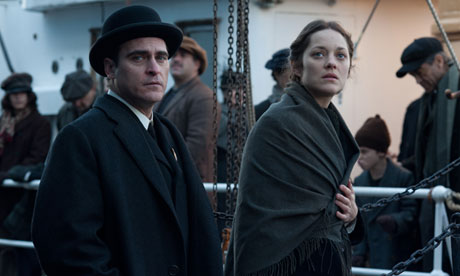
James Gray has come to Cannes with a gloomy and baffling period drama set in 1920s New York among the huddled masses yearning to be free in the new world. It begins promisingly enough. In the first half-hour, The Immigrant looks like a subdued, complex and intriguing drama with Marion Cotillard holding centre stage as Ewa, the scared young Polish woman, just off the boat, who must do what she can to survive.
But the movie becomes a bizarre tragi-melodrama on a single plaintive note of despair: sluggish, at times entirely implausible, and trapped in its own Stygian gloom as the sad-eyed Ewa gets involved with Bruno (Joaquin Phoenix), the MC of a saucy burlesque show, and his cousin, the twinkly-eyed stage magician Orlando (Jeremy Renner).
In theory, Ewa's unlikely encounter with the rackety world of showbusiness should inject some humour or gaiety into the movie; some energy, anyway. But the film turns out to be heading nowhere, at a leaden funeral-march pace. No one expected Gray to re-make The Night They Raided Minsky's. But he seems to have overlaid his movie with a thick sepia of solemnity which makes the sudden outbreaks of frantic action look all the more deeply strange. It looks sometimes like a Woody Allen comedy with the jokes removed.
Cotillard herself is incapable of giving a bad performance and she certainly carries the movie's opening act, lining up with her ailing sister in Ellis Island, having tensely endured the unspeakable boat journey from the old country. But when her sister is quarantined with suspected TB and Ewa herself is detained separately and threatened with deportation on a heartwrenchingly unfair "immorality" charge, she becomes desperate.
At this moment, Bruno arrives, courteous and well-dressed, claiming to be from the "Travellers' Aid Society". It becomes clear that, with a word here and a bribe there, Bruno can spring detainees from Ellis Island and recruit desperate, pretty girls to be dancers in his sleazy theatre, and that they are expected to earn money for him in other ways.
Bruno's initial scenes with Ewa are fascinating. He is not the usual charming or sinister rogue, but an opaque, intimidating man, who seems driven by forces other than money and lust. Neither is Ewa a straightforward heroine: she feels fear, shame, rage – and she steals. The stage is set for an absorbingly real story.
That is not, however, what we get. The Immigrant becomes a stifling opera of unhappiness, at an oppressive andante tempo, trudging onwards through its own heavy weather. Renner's role is featureless and dull, while Phoenix almost visibly struggles to make something of the Bruno part, to clarify it and make it come to life.
Everything about the way The Immigrant has been furnished and designed shows how genuinely concerned Gray is to make his film authentic. Yet, having exhaustively established that Ellis Island is a tough place and its officers tough people, Gray asks us to believe that it would lay on a lavish theatre show to entertain its hospital patients – starring Caruso, no less! Fancy society folk in Manhattan pay an awful lot of money to hear Caruso, and his fee must presumably be huge. Would the Ellis Island authorities really pay that kind of cash to entertain the poor immigrants? Or would Caruso do it for nothing?
The story reaches its climax as Ewa, riven with guilt and a Catholic fear of hell, becomes crucified on her own weird love-triangle. She may have found a kind of love with these lost souls; she may have arrived at a mysterious state of grace with these fallen, sinful people. That may be the implication of the movie's aria of pain. Gray is an intelligent director, always concerned to offer his audiences something other than the usual Hollywood formula pictures. The Immigrant is certainly different: but Gray seems to run out of ideas and the film is shapeless and unsatisfying.

